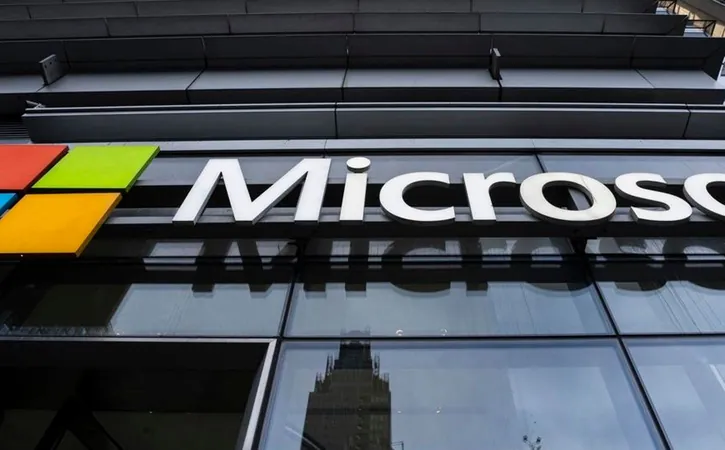
Microsoft Announces Major Shift: Goodbye Passwords for 1 Billion Users!
2025-01-21
Author: Jacques
Introduction
In a groundbreaking announcement, Microsoft has declared the end of the password era, warning its massive user base of one billion individuals about the escalating threat of cyberattacks. "Bad actors are aware that the time for passwords is running out, which is why we are witnessing a surge in password-related attacks," the company stated. In light of this, Microsoft is ramping up its defenses, blocking an astonishing 7,000 password attacks every second—a figure that has almost doubled in the past year. Despite these efforts, the tech giant believes that the ultimate solution is to eliminate passwords entirely.
The Future of Security: Passkeys
The future of security lies in passkeys, sophisticated authentication methods that allow users to log in with biometrics such as facial recognition, fingerprints, or personal identification numbers (PINs). These passkeys not only improve user convenience but also offer a significantly higher level of security by being less vulnerable to traditional hacking methods, which often exploit weak or reused passwords. Additionally, passkeys eliminate the common woes of forgotten passwords and one-time verification codes, ultimately reducing the volume of support requests Microsoft receives.
Challenges in Transitioning to Passwords-less Future
However, this transition to a password-less future is not without its hurdles. The UK's National Cyber Security Centre (NCSC) has warned of "significant bumps in the road" that must be addressed before widespread adoption can become a reality. Issues such as inconsistent support for different types of passkeys and users' concerns about device loss pose significant challenges. For instance, many users are unclear on what to do if they lose a device that holds their passkeys, which can significantly impact their ability to authenticate securely.
Factors Impeding Mass Adoption
The FIDO Alliance, which promotes open standards for authentication, has noted a 50% increase in passkey awareness since their introduction two years ago. While many users are eager to adopt this technology, the transition from traditional passwords remains uneven. The NCSC identified critical factors impeding mass adoption, including:
1. Inconsistent Support
Different platforms offer various types of passkeys, creating confusion for users and hindering website support.
2. Device Loss
Concerns about what happens if a device containing passkeys is lost or damaged need clear solutions.
3. Migration Issues
Users may want to move their passkeys between different services, but current processes are cumbersome.
4. Account Recovery Risks
Attackers are increasingly targeting recovery processes for passkey accounts, requiring enhanced security measures.
5. Terminology Confusion
Different terms for passkey logins across platforms can discourage user adoption.
6. Accessibility for Shared Devices
In households with shared devices, ensuring exclusive access to accounts can be complicated.
7. Implementation Challenges
Services using multiple domains for authentication complicate user experience.
8. Usage Clarity
There is no consistent agreement on when and how to use passkeys in login processes.
9. Multi-Factor Authentication Status
Uncertainty remains about whether passkeys can be classified as multi-factor authentication equivalents.
10. Syncing and Sharing Concerns
The security of passkeys that can be synced between devices is yet to be fully established.
Conclusion
Despite these challenges, the commitment to resolving them is strong among technology providers, with coordination led by the FIDO Alliance. This collective effort aims to diminish the prevalent issue of weak passwords that contribute to cybercrime.
Microsoft acknowledges the complexity of this transition and is deliberately taking its time. The company is conducting extensive user studies to determine the most effective ways to encourage individuals to adopt passkeys, emphasizing that mere enrollment is just the first step. "Even if our billion users transition to passkeys, the risk remains if users have both a passkey and a password. Our ultimate aim is a world where only phishing-resistant credentials exist," Microsoft noted.
As we edge closer to a password-less digital landscape, users should stay vigilant and informed about the evolving security measures and how to navigate this significant change without compromising on safety.
Stay tuned as we continue to report on the future of online security and innovation!









 Brasil (PT)
Brasil (PT)
 Canada (EN)
Canada (EN)
 Chile (ES)
Chile (ES)
 Česko (CS)
Česko (CS)
 대한민국 (KO)
대한민국 (KO)
 España (ES)
España (ES)
 France (FR)
France (FR)
 Hong Kong (EN)
Hong Kong (EN)
 Italia (IT)
Italia (IT)
 日本 (JA)
日本 (JA)
 Magyarország (HU)
Magyarország (HU)
 Norge (NO)
Norge (NO)
 Polska (PL)
Polska (PL)
 Schweiz (DE)
Schweiz (DE)
 Singapore (EN)
Singapore (EN)
 Sverige (SV)
Sverige (SV)
 Suomi (FI)
Suomi (FI)
 Türkiye (TR)
Türkiye (TR)
 الإمارات العربية المتحدة (AR)
الإمارات العربية المتحدة (AR)